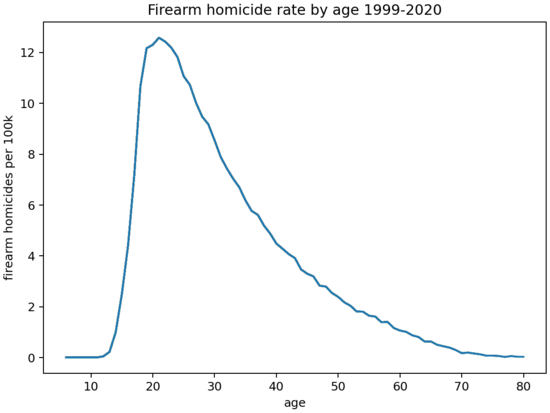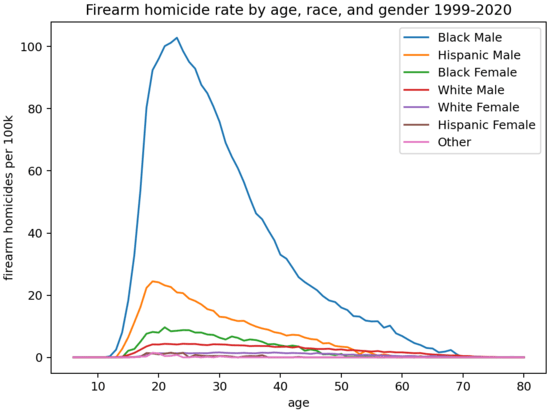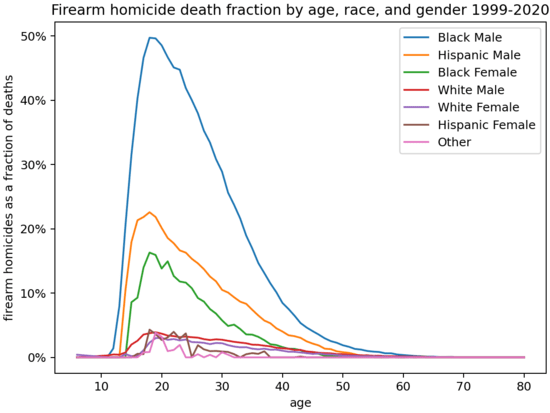Here's a pattern that doesn't work very well: a tragedy catches our attention, we point to statistics to show it's an example of a distressingly common problem, and we propose laws to address the issue. Except the event is rarely representative of the larger problem, and so these policy changes won't help much with the issues reflected in the statistics. Instead, we should combine the anger and passion the tragedy evokes with a deeper interpretation of the statistics to identify what changes we most need.
For example, with the recent Nashville school shooting a lot of people are giving statistics like how there were 600+ mass shootings and 51 school shootings in 2022, or how guns are now the largest cause of death for children. But let's look into the kind of events these statistics represent.
The Gun Violence Archive maintains a listing of mass shootings: incidents in which at least four people are shot. They link news stories for each, and while they're frustrating and depressing they're very rarely "someone senselessly shoots up an elementary school". Instead they're people fighting and one of them pulls out a gun, people arguing at a park and then escalating to shooting on the highway, or a targeted attack at a garage. In half of the incidents exactly four people are shot, since most shootings are fewer people and the cutoff is four.
Education Week maintains a listing of school shootings: incidents in which at least one person is shot on school property or a school bus. Looking over them they're again mostly not the kind that makes national news. Two teenagers fighting in the schoolyard and one of them has a gun, a drug deal between two armed people in a school parking lot escalates into a shooting, or an adult was shot in their car in the school parking lot after a basketball game.
If you look at the Nashville school shooting, or others that have made especially large impacts nationally, they're attacks against younger kids. And hearing the "number one cause of death among children" statistic you might think this is common. But "children" here is being used literally to mean "under 18": 47% of those dying were 17, and 76% were 16 or 17. Only 18% were under 15:
Source: CDC, code
None of this is to minimize the suffering and loss these shootings represent: ten incidents in which four people die isn't better than one in which forty die, and someone dying at 17 isn't more acceptable than dying at 9. All of these deaths are too many. But if we're going to make things better, we need to target our responses to the common cases, and not the unusual ones that make the news.
Here's the demographic breakdown:
And as a proportion of deaths at each age:
That the impact of these shootings so strongly reinforces existing disadvantage makes the misplaced focus especially tragic.
Translating this into policies, the efforts to re-ban assault rifles don't make sense: gun homicides are overwhelmingly from handguns. Same with red flag laws, where a judge can order someone's guns confiscated, since most of the homicides are via illegally possessed guns which could already be confiscated. An approach of enforcing existing laws on handgun possession, however, making it less likely that teenagers and young adults who get into fights will be armed, is the kind of policy that fits the bulk of the problem, and sounds much more likely to make an impact.



It’s not clear to me that putting effort into enforcing existing regulations is more feasible for many of the folks advocating assault rifle bans, nor is it clear to me that it’s a significantly higher impact approach.
Re: feasibility — Your examples of folks advocating additional legislation are federal and state politicians, while my impression is that most handgun enforcement actions in the U.S. traditionally rely on law enforcement agencies at more local levels. Thus, it’s not clear that the folks pushing such policies are in as good a position to affect the prioritization of handgun law enforcement, which (at least somewhat) counteracts the benefit of pursuing a less controversial remedy.
Also, in particular, the politicians you refer to are Democratic party politicians. The creation of gun laws is already a highly partisan issue in the United States, with Democratic party associated with efforts for more gun control and the Republican party associated more with gun rights. My impression is that enforcement of gun laws is currently seen as a much less political issue. If Democratic politicians start prominently pushing for shifting enforcement priorities toward a political goal of keeping guns off the street, I think that risks turning gun law enforcement policies into just another front in the political debate over gun control legislation. In the worst case, that could actually result in negative impact from Democratic politicians (particularly a Democratic U.S. president) pushing such policies, because it creates a potential incentive for Republican politicians at the state and local level to decrease such enforcement in order to maintain their political image of “defending the second amendment”.
Re: impact — I agree that an assault rifle ban would have fairly low impact on the bulk of the incidents indicated in the statistic. However, the limited reporting I’ve seen on efforts to enforce existing regulations has generally indicated that simply scaling up existing efforts in this area doesn’t actually impact gun violence much either. One example of such reporting (chosen for being particularly easy for me to remember how to re-find in this moment, rather than for being the most compelling report) is https://www.themarshallproject.org/2023/03/23/gun-laws-violence-chicago-policing-what-to-know, which observes that increasing enforcement of gun possession laws has “not substantially reduced shootings in Chicago. In fact, as possession arrests skyrocketed, shootings increased — but the percentage of shooting victims where someone was arrested in their case declined.”
If we need to introduce entirely new tactics for enforcing the existing laws in order to get the outcomes we’re expecting, such a constraint will correspondingly decrease the feasibility of rolling out that approach.
(Also there may be a degree to which, for politicians, impact is more palpably associated with the avoidance of political crises centered around gun violence, rather than actually avoiding gun deaths. But I’d rather not focus too much on that one...)